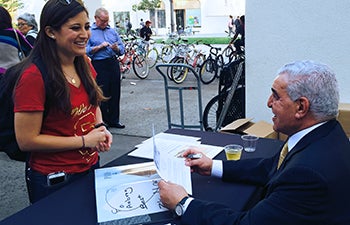Preserving Antiquity
Egyptologist Zahi Hawass will never forget the morning of Jan. 28, 2011 — three days after the first demonstrations in Egypt’s revolution — when looters broke into the Egyptian Museum of Antiquities in Cairo for the first time in its 113-year history.
“I said, that’s it — there are no police in town, so people can do anything,” said Hawass, who had just experienced the initial movement to overthrow Egyptian President Hosni Mubarak. “But I came to the museum the next morning, and I saw a group of young people with their arms together, and they said, ‘We protected the museum.’ ”
However, the barricade of youths alone was not enough to stop the hundreds of thieves.
“At midnight, I called the head of the army and said, ‘Without the help of the military, we will lose all our treasures,’ ” Hawass recalled during his lecture “Pyramids, Mummies and Cleopatra: Recent Discoveries,” delivered March 10 on USC’s University Park campus.
The audience included undergraduate and graduate students, professors and community members as well as Ambassador El Husseini Abdelwahab, the consul general of Egypt; Nancy Thomas, senior deputy director of the Los Angeles County Museum of Art (LACMA); and Egyptologist Kara Cooney.
Egyptian troops came that night, stopping the plunderers and ultimately saving most of the museum’s most valuable artifacts, including the majority of the mummies.
“We must be thankful that they were looking for gold and not archaeological masterpieces,” Hawass said. “And we must also be grateful that the museum was dark and they could not see anything — the gold room, the mask room or the mummy room.”
Hawass’ lecture and book signing focused on his extensive career as an Egyptologist. Among many other accomplishments, Hawass discovered two previously unknown Old Kingdom pyramids and spearheaded an initiative called the Egyptian Mummy Project (EMP), which used modern forensic techniques such as DNA analysis to answer questions about the royal mummies.
“Zahi is deeply concerned with the conservation and preservation of Egypt’s monuments,” said Lynn Dodd, associate professor of the study of religion and director of USC Dornsife’s interdisciplinary archaeology undergraduate major, in her introduction to the lecture. “He really has brought the drama and excitement of Ancient Egypt to a wide public.”
Hawass is the former Egyptian Minister of Antiquities and director of excavations at Giza, Saqqara, Bahariya Oasis and the Valley of the Kings. He received his Ph.D. in 1987 from the University of Pennsylvania, where he studied as a Fulbright fellow.

Hawass signs copies of his books in a reception following the talk.
“USC Dornsife’s School of Religion and members of the interdisciplinary archaeology undergraduate program were very pleased when the Provost and Dornsife Dean’s offices teamed up to invite Dr. Hawass to campus,” Dodd said. “USC stands together with Egypt and other countries in a quest to preserve and understand the traces of human creativity and innovation from the past.”
Jennifer Massey ’15, a history major, said Hawass’ visit “reinvigorated her early love for ancient Egypt.”
“I am not easily star-struck, but seeing the most famous Egyptologist in person made me quite giddy,” Massey said. “Zahi Hawass was a big part of my childhood and one of the reasons I fell in love with history. My mom and I would never miss his numerous television appearances on ancient Egypt.”
In addition to being a distinguished author, Hawass received an Emmy from the Academy of Television Arts and Sciences for a special on ancient Egypt produced by KCBS in Los Angeles.
While Hawass is deeply fascinated with the past, he also holds vast knowledge of modern scientific techniques, employing them to unlock ancient mysteries.
For the Egyptian Mummy Project, he led a team that used Computed Tomography (CT) scans on the mummy of King Tutankhamun to learn more about the true cause of the Pharaoh’s death. They then continued to scan mummies, hoping to understand the lives and deaths of important figures in Egypt’s history, such as Hatshepsut and Nefertiti.
“Entering his tomb and meeting King Tut for the first time, seeing his buck teeth, was really something,” Hawass said at the lecture. “But I never believed in the curse of King Tut until, when we finally had a chance to put his mummy in to the CT scanner, the machine suddenly stopped.”
However, the scans and DNA tests were able to help debunk theories about King Tut’s early death. After two years of work, the researchers determined that the boy king had died of malaria, Hawass said.
“Since he was first discovered, it was thought that King Tut was murdered because of a large hole in the back of his skull,” Hawass explained. “However, science was able to reveal that the hole was made after his death to insert liquid for mummification.”
Although his heart will always be in the Valley of the Kings, Hawass’ current crusade is to raise awareness for a global audience that Egypt’s prized artifacts must be respected and preserved — especially in light of the country’s current political turmoil.
“During the time of the revolution in 2011, people began to attack archaeological sites.” Hawass said. “There was illegal excavation everywhere.”
He concluded, “My goal now is to help restore and preserve Egypt’s monuments and museums so that crucial chapters of world history — that have survived for nearly 30 centuries — will not be destroyed.”